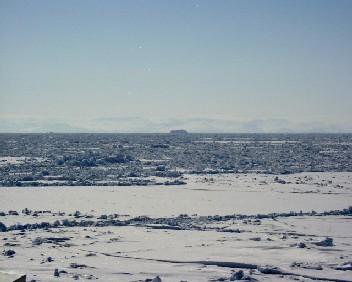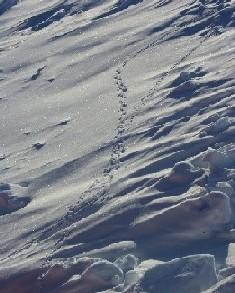29 April, 2000
Trafficability Part I
DRAFT
April 29, 2000
Daily Data (20:30):
Lat. 6809.496 N
Long. 06316.883 W
Heading 215.916
Air Temp. -12.23 C 9.99 F
True Wind Dir. 11.0
True Wind Speed 4.1
Dear Everyone,
Communications connectivity may soon become an issue. At our daily 08:00
science meeting, we were informed that during the night signal strength
dropped from 51% to 37% for the amount of data that could be passed. The
ship must park and align itself with the satellite and even then it is
difficult to link. We may only attempt to connect twice a day now.
It's a bright and sunny day and even though the ambient outdoor temperature
is icy, the bridge is quite warm. It was a nice place to spend the
afternoon. Stevie Avalakjak, our Inuit guide during this phase of the ice
trials, was at his usual solitary location scanning the ice. Although no
bears were seen, Stevie pointed out a clean set of tracks following a lead.
The bear was obviously searching for a fresh luncheon of seal.
Alex Iyerusalimskiy of Science and Technology Corporation (STC) Columbia MD
for the USCGC Healy Ice Trials 2000, spent a few hours with me this
afternoon during his duty watch in the bridge. I learned about
trafficability.
Alex explained that the information he needs for his trafficability studies
cannot be done by automated technology. They can only be conducted through
human observations. This involves detailed observations of the ice
conditions and the performance of the Healy at the time those specific ice
conditions occurred. Key questions are: How did the ship perform? What
generated this performance?
But first, the vocabulary of the day:
From MANICE; Manual of standard Procedures for Observing and Reporting Ice
Conditions, Canadian Ice Service, April 1994.
Lead: Any fracture or passageway through ice which is navigable by surface
vessels.
Vocabulary from Alex Iyerusalimskiy:
Channels: Electric wires provide signals from sensors (voltage) into
computer real time data acquisition systems. An engineer takes this voltage
and converts it to an engineering unit (such as tons, pressure measured in
tons per sq. ft., torque on the propeller shaft in ft-lbs, KW on the
electric motor) that the engineer uses for design.
Load: The force usually defined as normal to the ship shell plating that is
generated by the impact or collision between the ship and the ice. This
force is localized by contact area.
Scantling: This is the thickness of the ship's shell plating and the weight
of the frame.
Naval architects need the load on the structure to determine the scantling.
The first purpose of trafficability studies on the USCGC Healy is to link
and correlate the parcticular ice conditions with the specific data recorded
by the data acquisition system's channels. There is 24-hour video filming
of the ice from the ship's conning station. This video records date and
time to the second. It serves as a visual reference when analyzing the data
collected from the extensive network of channels on board.
Trafficability studies are needed for analysis of data from approximately
200 channels recording every imaginable engineering detail. Gauges are
installed on the propeller shafts. Torque and machinery dynamics are
recorded. Sensors show rudder angle and the ice load in order to determine
how the rudder was loaded by the ice.
How strong is the hull, the vessel's structure? Ship structure is
instrumented with strain gauges placed directly onto the Healy's frame to
essentially measure the load. In the Healy trafficability studies, the ship
is assessed in terms of ice performance from all points of view.
The following is an example from a trafficability data sheet for "Icebreaker
Healy 2000 Arctic Ice Trial". This data is recorded every half hour.
SHIP DATA
ICEBREAKING MODE
Cont. Icebreaking (see codes)
Backing & Ramming (no. of times)
Penetration Distance (ship lengths)
Ramming Cycle Time (min.)
PROPOULSION SYSTEM
Propeller shaft Power starboard
Propeller Shaft Power port
Propeller Shaft Torque starboard
Propeller Shaft Torque port
Propeller Shaft RPM starboard
Propeller Thrust RPM port
Propeller Thrust port
WATER LUBRICATION SYSTEM
Wash Mode (off, on)
Thruster Mode (off, on)
Tomorrow look for part two of trafficability.
Today has been a day of backing and ramming of ice up to easily two meters
in depth. Pauses of near quiet, gentle backing and then the upsurge of
speed and vibrations that can make even typing challenging. At this moment
we are very comfortably cruising through an ice floe of around two feet
deep. As the Healy continues north, the ship must pass through a
significant distance of difficult traversing.
Career opportunity! Alex suggests the need for Naval Architects
specializing in Ice Technology and recommends the U. of Michigan.
Best regards,
Sandra Kolb

Alex Iyerusalimskiy at the trafficability table in the Healy's bridge. photo by Sandra

Ice floes and rubble fields with an iceberg in the center back. photo by Sandra

Polar bear and cub tracks on an ice floe. photo by Sandra
Contact the TEA in the field at
.
If you cannot connect through your browser, copy the
TEA's e-mail address in the "To:" line of
your favorite e-mail package.
|
